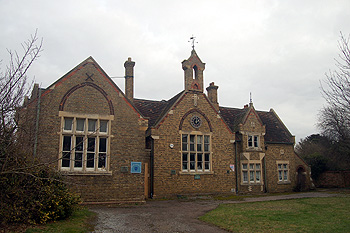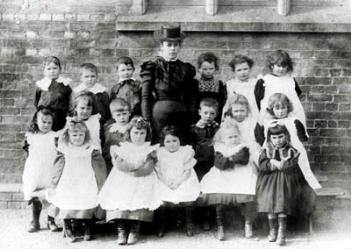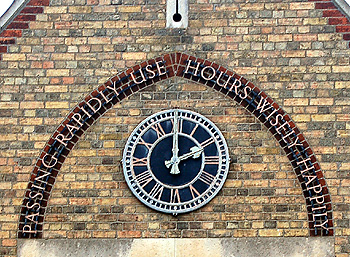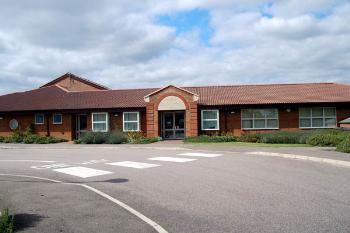Elstow School

The former Elstow village school February 2012
The first Education Act was passed in 1870 (more correctly it was known as the Elementary Education Act). It was a milestone in the provision of education in Britain demonstrating central government's unequivocal support for education of all classes across the country. It also sought to secularise education by allowing the creation of School Boards. These were groups of representatives, elected by the local ratepayers and the Board had the powers to raise funds to form a local rate to support local education, build and run schools, pay the fees of the poorest children, make local school attendance compulsory between the ages of 5 and 13 and could even support local church schools, though in practice they replaced them, turning them into Board run schools (known as Board Schools). Naturally, and luckily for local historians, the Act required a questionnaire of local schools in 1870. At the time Elstow had "no efficient school" and required a school for a hundred in the village: "If the school for which application for a building grant has been made be built and a certified teacher appointed, no further accommodation will be required".
Directories later call this new school a National School and certainly there are references to it in the vestry minutes for 1870 [P128/8/1] suggesting that the application for a grant had been made to the National Society. Be that as it may, a School Board was formed for Elstow on 29th May 1873.
The school opened in 1873 as a Board School, directories note that it had cost £1,600 and had space for a hundred scholars. In 1874 the buildings and land were conveyed formally to the School Board by Samuel Whitbread,
Lord of the Manor of Elstow, who had given the site [SB15/1].
Despite being a secular school religious education was not ignored as the School Board regulations [SB15] insisted: "The school shall be opened in the morning with prayer, and by the reading of some portion of the Bible. The school shall be closed in the afternoon with prayer, and the singing of a hymn".
A land mark Education Act was passed in 1902, coming into effect in 1903. It disbanded the School Boards and gave day to day running of education to newly formed Local Education Authorities, usually the county council, as in Bedfordshire. The old Board Schools thus became Council Schools whilst the old National, British and other non-Board schools became known as Public Elementary Schools. Elstow Board School duly became Elstow Board School and, unlike some other schools in the county scholars of both sexes continued to be taught together along with infants.

Elstow schoolchildren about 1900 [Z50/142/105]
The photograph above shows a school class at Elstow about this time, the individuals (left-right) are: top row: William Breed; unknown; unknown; Ethel Daisley, the teacher; Elsie Wells; unknown; unknown. Middle row: unknown; Lily Whitehouse; Leslie Pestell; Ernest Dickens; Winnie Horney; unknown. Bottom row: Ella Harding; Gladys Keep; Gertie James; Maude Cirket; unknown.
In 1905 a loan was taken out to enlarge the school [CTM17/38]. Bedfordshire & Luton Archives & Records Service has a scrapbook of cuttings of visits made to most Bedfordshire Schools by School Inspectors for a period from just before the First World War through the inter-war years [E/IN1/1]. The first inspection in the scrapbook dates to 1911, when average attendance was 149. The inspector found: "The School is in very good order and is most carefully and capably taught, the Head Teacher's supervision is methodical and thorough, the work is carefully arranged and prepared, and the general level of attainment is quite satisfactory. In the Infant's Division the Teaching of Reading and Number requires some further attention, and the discipline should be firmer". The headteacher mentioned was Thomas James. Two years later the inspector noted: "This school continues to be, in all respect, in a very creditable state of efficiency" he also noted that the infants had shown improvement.
The next inspection was not until 1919 when the inspector stated: "In its unostentatious way this School continues to do the good work that has long distinguished it. At each visit of inspection the Headmaster and his staff, whatever their difficulties may be, are found doing their duty cheerfully, and the children make adequate progress". He further noted: "It speaks well for the character of the Composition that an old boy who has been soldiering in Egypt and Palestine, has presented to the Head Master a voluminous memoir containing an exact account of his life with the forces. Gardening was begun in 1917, with great success…" The reason for gardening beginning in 1917 was that the country was close to starvation due to the effects of U-boats on merchant shipping and every opportunity was taken to produce food. The inspector's final remarks are revealing: "The school has long had a name for training intending teachers. The two monitoresses now on the staff have both done well in their examinations".
It was all change at the time of the next inspection in 1923: "Since the last report a new Head Teacher has taken charge and new methods have been introduced, with success. The aims of the master, the care and thought evident in the teaching of all 3 groups in the Upper Department, and the awakened interest of the children are deserving of praise, and the outlook for the future is promising". The new headmaster was Robert A.J.Wadsworth. The inspection of 1925 was purely devoted to reporting on the buildings and their defects before expected improvements by the Local Education Authority. The next year the inspector recorded: "The curriculum of this school develops many valuable interests and activities, has been very carefully considered, and is well worked out. In the last 3 years the children have won many successes in open competition in Music, Elocution, Folk dancing, and in connection with the Wireless Broadcasting Lectures. The lessons in Gardening, also, have interested the boys. The tone is excellent, and the Head Master and his capable Staff deserve great credit for their very good work and the conduct of the school". Also in that year the inspector investigated the school garden finding: "The garden is on light, hungry soil and green manuring has been adopted as a means of increasing its retentiveness".
Mortgages were taken out in 1927 [CTM17/79] and 1930 [CTM17/102]. These were to cover the building of additional classrooms as the school population grew greatly.
The final report in the scrapbook is a very log and detailed one from 1933, when average attendance had risen to 267. The report gives the reason for this: "This school, situated in a village on the proposed new boundary of Bedford Borough, receives all the children from Elstow, and those of 11+ from the contributory schools of five villages and three districts - New Harrowden, New Fenlake and Shortstown - in which there is no school. Two of these are mainly interested in market gardening, the others are agricultural. Elstow itself, on the edge of Bedford, is influenced by the proximity of the town, as many parents of scholars work in the Borough. The others are mainly farmers, smallholders, engineers, mechanics on farms, or farm labourers. The school therefore has to cater for a wide variety of interests. This it does mainly through practical work, the conditions for which are far from ideal, as the building of rooms for practical work, plans for which were submitted by the Local Education Authority and approved by the Board [of Education], has not yet been carried out. The success in the training given is very remarkable in the circumstances, and the versatility, ability, and organising powers of the Head Master call for special recognition".
There follows an interesting breakdown of numbers of children entering various walks of life since the increase in numbers, which were as follows:
- 57 to "rural occupations and domestic service";
- 28 to secondary schools [almost certainly to Harpur Trust schools] - 16 fee paying, 10 to free places and 2 scholarships;
- 24 to trades such as carpenter, cabinet maker and printing apprentice;
- 15 to factories including biscuit making [Peek Frean], crayon manufacture [Cosmic Crayon] and leather working [R.B.Sanders] "includes one boy operating a new press, the only one in England";
- 13 to engineering [presumably mainly to W.H.Allen];
- 6 as clerks and shop assistants;
- 3 to the Army;
- 2 to the Royal Navy.
The School logbooks give a very clear snapshot of what life was like for children at school during the Second World War, all the following being obtained from one logbook [SDElstow1/4]. Children were evacuated from London and had to find somewhere to live: 1st September 1939: “London children arrived at the school. Several members of the staff came back from their holidays to assist the headmaster in the billeting of the children and teachers”.
The children came from a junior school in Cricklewood. There were 64 in total. They were taught at Elstow School: 11th September 1939: “three senior classrooms have been allotted to the London school children and they are working quite separate from the Elstow school proper”.
Local families helped to make the evacuees feel at home; especially at Christmas: 21st December 1939: “The Elstow parents have subscribed very handsomely towards the Christmas party we are giving to the London school children evacuees”.
The curriculum was also affected by the war: 13th September 1939: “war time syllabuses have been prepared by the handicrafts and domestic subject teachers.’ 9th March 1940: “War time gardening. Boys borrowed a seed drill and set the onions and carrots”.

Inscription on Elstow village school February 2012
The third of the great Education Acts was that of 1944 which established the principle of County Primary Schools for children up to the age of 11, at which time they took an examination to determine the nature of the secondary school they would attend until they were 15, the most academically able going to grammar schools, the rest to secondary or secondary modern schools. Elstow duly became a County Primary School. A dining room and kitchen was added in the late 1940s [RDBP3/777A].
Two later inspector’s reports for the school also survive [E/IN1/2]. The first is from February 1950: “This school, situated on the fringe of the Bedford Borough boundary, now caters for 389 children aged 5 to 15 years as against 267 in 1947. Only 65 children are drawn from the village; of the remainder 81 juniors and infants come from Bedford – having been transferred from Pearcey Road schools in 1948/9 – 66 from Wilshamstead (including 18 juniors and 6 infants who attend voluntarily), 66 from Shortstown where there is no school, 15 from Eastcotts, 10 from Cardington, 20 from Cople, 14 from Willington, 30 from Haynes and 13 from Harrowden. The total comprises 199 seniors, 123 juniors and 67 infants. These are arranged in 11 classes”.
“Teaching accommodation consists of nine class-rooms, four in the original block built in 1874, and five in a separate block erected in 1929. A third unit contains a laboratory, a housecraft room, a workshop and a staff room. A kitchen and dining room is of recent erection”.
“The school has enjoyed a high reputation locally for many years, which, coupled with rapidly increasing numbers and staffing instability, provided a challenge to the new Head master when he was appointed in 1947. He has met this challenge. His inspiring manner, personal industry, clarity of purpose, high ideals and leadership already have a beneficial influence on the school as a whole. He has created a flexible organisation and welded into a team the more experienced colleagues and no less than eight masters and mistresses appointed within the past two years. In all his efforts he has been fully supported by the Senior Mistress, who besides being a skilled teacher, especially of Needlecraft, sets a high personal example of unstinting effort”.
“There is much evidence of a close relationship between the school and parents; the renowned May Day Festival, Sports days, Craft Exhibitions, the pupils’ terminal reports, the school uniform and the Head Master’s visits to the villages are but few examples of this”.
“A friendly spirit permeates the whole school and the children strive to attain the high ideals of comradeship and behaviour set before them; the confident and self reliant attitude of the children is the result. Indicative also is the responsibility carried by the Prefects who, among any routine jobs, conduct the business of the School National Savings Group and care for the library of 400 books from the County Library. The ability of the members of the recently formed Young Farmers’ Club to conduct their business with confidence in the absence of adults also reflects valuable training, as indeed does the performance of the School Choir which practises out-of-school hours. Here, too, should be mentioned the faithful and loyal service given to the school by the caretaker for the past 20 years”.
“A well defined curriculum has been formulated and its interpretation has been notably successful with the younger children. The lively and purposeful work of the two Mistresses in charge of the Infants’ classes is creditable. Of special note is the quiet concentration of the children that arises from a wide variety of experiences prepared for them and from opportunities to express their own ideas in pictorial or written form. No doubt greater reality in Number work will emerge in the near future”.
“One of the three teachers of the Junior classes was absent during the inspection. In the two upper junior classes it is evident that every effort is being made to provide opportunities for learning from first-hand experience. Natural ways of encouraging speech and helping language development are being explored and much of the written work is both purposeful and satisfactory”.
“Of the six senior classes, two contain the slower children, and it is significant that the teaching of practical subjects, Handicraft (wood and metal), Housecraft and Needlecraft has met with undoubted success. Gardening too arouses interest which should be intensified now that fruit cultivation on an additional half-acre of ground is being developed. It is unfortunate that the teaching of Science is less satisfactory; the children have few opportunities for experimentation and they waste valuable time in copying notes that contain uncorrected errors. Attainments in the scholastic studies are uneven and the present degree of specialisation in English and Mathematics calls for reconsideration if fluent use of the mother tongue and ability to apply mathematical rules to everyday life are to be secured. The Headmaster is aware of these weaknesses and of those applying to Art teaching, and he is planning a concerted effort to remedy them”.
“Commendable attention is given to Health education; the children are trained in habits of cleanliness and to enjoy their games, exercises and dancing. The midday meal is well prepared and served to 300 children daily in two sittings; all concerned merit commendation”.
“The spiritual side of school life made a deep impression on H. M. Inspectors who deemed it a pleasure to share in the dignified morning assembly in which the musical repertoire of the school showed to advantage. Religious Instruction finds its rightful place in the body of the time-table; in all the lessons seen good use was made of the Bible by the children and many passages were interpreted by the teachers with skill and sincerity”.
“It now remains to record the wide use made of visual aids and of school broadcasts, the generous supply of equipment by the Authority, and of the happy relationship with visiting students from the local Colleges”.
The second report dates from February and March 1957: “This is still an all-age school with a roll of 381 children as against 389 when the last report was issued in 1950.The contributory area remains unchanged except that few children are now drawn from within the Borough boundary. The rural schools account for 248 seniors, who are taught in six classes, each of which, with one exception, comprises 40 or more pupils whereas the 82 juniors and 51 infants are organised in three and two classes respectively. The large size of the senior classes makes it almost impossible to give individual attention to a number of children who appear to need special treatment and whose attainments are exceedingly low. This pattern will change, however, early in 1958, when the seniors will move to the new Secondary School and leave the two principal rooms, the Science laboratory and about three classrooms free to relieve the pressure on the Borough Schools south of the river”.
“Many of the pleasing features noted in the last report are still in evidence and the Head Master, appointed in 1954, is fortunate in having on his staff the experienced and capable Senior Mistress, who continues to exercise a highly beneficial influence on the girls. Indeed, with one exception – the Master temporarily in charge of 3A – the members of the staff, 14 in number, are hard-working, make good use of visual aids and of class libraries, secure much real work from the children, and give freely of their time to extra-mural activities, notably to the successful May-day festivities, to games and athletics and to the activities of the flourishing Young Farmers’ Club. Individually each makes a sound contribution to the education of the children over quite a wide field, including Religious Instruction, Physical Education, Art, Music and crafts; in Rural Studies, the school has won well deserved fame for the excellent work done in experimental field trials with agricultural and horticultural crops. In view of these achievements it is disappointing to find the general level of attainment in the basic subjects rather low in the senior classes. To improve it, it will be necessary for the Head master to give clear guidance about objectives and methods and to pay more attention to organisation, for example in the classification of the pupils and the avoidance of divided responsibility for the teaching of English in individual classes. The advisability of his having a definite teaching programme was discussed with him”.
“The infants continue to be well taught and their progression is sufficiently well maintained in the junior classes to enable them to work independently in Class 5 and to enjoy the use of books”.
“Throughout the school, the children are courteous, well behaved and have a feeling for humour and responsibility; from the morning assembly, too, there springs a sense of fellowship which seems to permeate their daily activities. The clear articulation of the singing at assembly is noteworthy. A spirit of co-operation is equally manifest among the 310 children during the mid-day meal, which is well prepared and quickly served”.
In 1966 a countywide Craft Centre was based at the school [CA2/82]. In the 1970s Bedfordshire County Council introduced comprehensive education, doing away with the 11+ examination and grammar schools and introducing a tier of school between the old County Primary and County Secondary Schools. Thus Lower Schools now taught children aged 4 to 9, Middle Schools from 9 to 13 and Upper Schools from 13 onwards. Elstow County Primary thus became Elstow Lower and Abbey County Secondary became Abbey Middle School.
Since 1870 Elstow school, be it Board, Council, County Primary or Lower had been based in the old buildings in the High Street, very close to the northern boundary with Bedford. In March 2004 the school moved to new purpose built premises in the new housing development of Abbeyfields which includes Housing Association social housing as well as the normal owner occupied dwellings. As Bedford, as well as Elstow, has grown the school has accepted pupils from the Mile Road and Elstow Road areas across the parish boundary. The old school premises, listed by the former Department of Environment, along with 3.77 acres were put up for sale in 2008.
On 1st April 2009 Bedfordshire County Council, the Local Education Authority, was abolished. Since this date Elstow’s Local Education Authority has been Bedford Borough Council.

The new Elstow Lower School September 2007